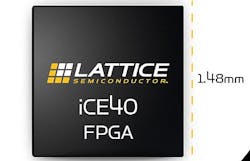Small, power-efficient FPGAs for context-aware mobile devices offered by Lattice Semiconductor
The iCE40 FPGA family comes in packages as small as 1.4 by 1.48 by 0.45 millimeters. With hard IP for strobe generators, I2C and SPI interfaces, the iCE40LM FPGAs deliver near-zero latency for context-aware systems with the real-time capturing of user and environmental inputs with minimal delay or error.
The small size of the iCE40 FPGAs enables integration of advanced functions such as IrDA, barcode emulation, and service LED in one chip with available logic for addition customer-defined functions, Lattice officials say.
Lattice has demonstrated the iCE40LM FPGA can reduce power consumption by 100 times over traditional application processor-only implementations to increase battery life.
The iCE40LM FPGAs give mobile device system architects the ability to add and customize sensor management functions and capabilities. The additions include the iCE40LM 4K, iCE40LM 2K, iCE40LM 1K FPGAs and consume little power, just under 1 milliwatt in active mode.
Meanwhile, the iCE40LP FPGA product line is being expanded through the addition of a 16-ball wafer-level chip-scaleW package for the iCE40LP 640 FPGA and iCE40LP 1K FPGA.
For more information contact Lattice Semiconductor online at www.latticesemi.com.
